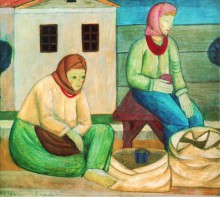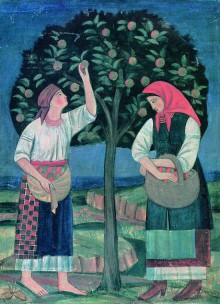Tymofii (Tymko), younger brother to Mykhailo Boichuk, lived a short but bright artistic life. Tymofii’s school and work years coincided with the fleeting years of the Ukrainian Academy of art within the Ukrainian statehood. He died in the year when the red-starred social experimenters turned the academy into a plastic arts institute. He will always remain 26...
Tymko Boichuk was born September 27, 1896 in a large family of Levontii Boichuk, in the village of Romanivka, Terebovlia raion, which had been the part of the Austro-Hungarian Empire. Aged 16, he came to Lviv as a student-apprentice of his older brother Mykhailo.
At the invitation of the Russian Archaeological Society, which heeded to the advice of Vasyl Krychevsky, the Boichuk brothers, together with Sofia Nalepinska and Mykola Kasperovych, carried out the restoration of icons at the Church of Three Saints in the village of Lemeshi in Chernihiv region. But the war disrupted their undertaking. As subjects of the Austrian Empire, the artist brothers were interned “to exile” – first to Uralsk, and later to Arzamas. Under convoy and marginally starving they had remained there until the revolutionary upheavals of 1917.
After returning to Ukraine, to Kyiv, in December 1917, Tymofii joined the workshop of icons and murals (later renamed into a studio of monumental painting), headed by his elder brother, in the Ukrainian Academy of Arts.
Still at the Academy, in the summer of 1919, Tymko Boichuk and other students of the monumental workshop – Vasyl Sedliar, Oksana Pavlenko, Ivan Padalka – took part in the decoration of four Lutsk barracks buildings in Kyiv. Tymofii created several compositions there, including Plowing (only a damaged photographic reproduction survived to this day), The Red Army Camp, From One Pot, and together with Maria Trubetska – Demonstration and Meeting with the Flags. The artist’s compositions struck with a skilful combination of “lyrical origins with the epic elevation of a simple fact of life.” A witness to these paintings, art critic Ivan Vrona, reminisces: “...in the artists’ collective, this gifted young fellow was the right hand of his older brother and had unquestioned authority among all junior – in experience and skills – students of Mykhailo Boichuk.”
This first collaboration of the students and the teacher, which had been full of its own hardships, teamwork, friendship, and enthusiasm, was savagely destroyed in 1922. But judging by surviving photographic reproductions, this work “has introduced new revolutionary themes and symbolic images of the new life into the creative practice.”
In those days, the idea of monumental art revival begins to take an important place in the works of Ukrainian artists. It was believed that “only fresco is able to consistently reveal the whole story, not just one of any given episodes, and submit the facts in their dialectical development,” and besides “the language of monumental painting is brief, summarizing, clear, akin to the language of a skilled orator.”
The next collective work in which Tymofii Boichuk participated, was the decoration of Kyiv Opera House, dedicated to the All-Ukrainian Congress of District Executive Committees (1919) – together with Serhii Kolos he created a monumental panel Smith – and the decoration of Cooperative Institute (1920). Both of the works did not survive to our time either.
Easel works of the artist have preserved: Two Women with Seeds, Planting Potatoes, Portrait of a Girl with a Boy, Market, Pastures, In a Shoe Shop, Feeding Pigs, Near an Apple Tree (1916-20).
All of the artist’s works are stylistically uniform and lapidary. For example, in the work Near an Apple Tree, Boichuk has elegantly solved the problem of techniques synthesis between icon and proto-Renaissance painting. To outline the elegant decorative crown of the apple tree, the artist depicted the sky as an integral monochrome spot, according to the tradition of Byzantine art. The hills, as befits to the iconographic canon, shrink to the horizon. At the same time, this piece of art strikes with the complexity of color, which is slightly different from the restrained and muted color scheme of Boichuk’s school.
In the genre of book graphics, Tymko Boichuk created a series of illustrations for the book of Ukrainian Legends, published by Voloshka collective, and the illustrations and the cover to Periwinkle children’s book (1919).
In March 1922, Tymofii Boichuk passed away. After his death, his works had been on display at Ukrainian art exhibitions in Moscow, Kharkiv, Venice (1927-28). A part of them disappeared after the arrest of his elder brother, and some, which had been stored at the special fund of the State Museum of Ukraine, were destroyed by the decision of a special commission on September 8, 1937: Under Apple Trees, Portrait of an Old Man, Portrait of a Girl with a Boy.
The “Directory of Tymofii (Tymko) Boichuk’s Surviving Works” is still yet to be created by the museum workers.








